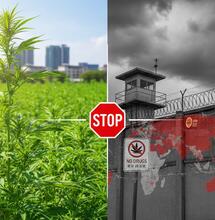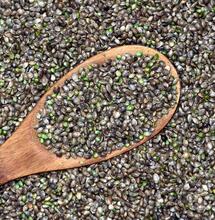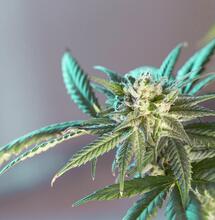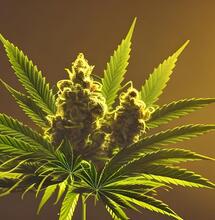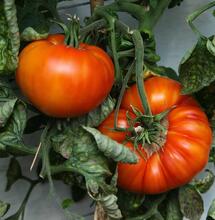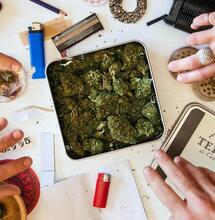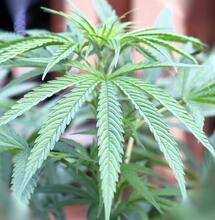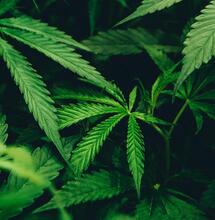Better Buds with Mr. Bill: One-Fingered Leaves

Mr. Bill is ready to assist you by drawing upon over twenty-eight years of active grow shop experience - including answering growers' questions about the hydroponic industry. Before Mr. Bill opened his first store he worked in the agricultural industry for five years, growing tobacco. Our plant fix-it guy, invites you to ask him questions so that you can achieve better yields.
Hi,
I have a question about one of my plants. So, I grew them outside; they germinated and everything from day one. They should have all their nutrients because we used a basic mixture for soil. Here are some pictures, so you can get a better idea. If you can't tell, it's missing the whole other side of the plant and its first two real leaves are huge, compared to a normal plant.
Jordan
Hi Jordan,
You're correct; that is weird. Firstly, be certain to use only a gentle medium when germinating - this is often actually labeled 'seedling soil' in the garden centers, grow shops, etc. Seedling soil contains far less nutrition than regular soil, as the Cannabis seed - which is actually an 'achene' or nut, rather than a seed - contains nurturing proteins and other compounds that naturally progress from inside of the seed, to seedling (tap root), to round baby leaves that don't look like ganja (cotyledons), to the first set of 'true' leaves. You don't seem to be getting 'true' leaves, as there are usually two cotyledons, then a one-fingered set of true leaves, then three fingers on your first set of large leaves. From my experience, either inappropriate lighting or too much nutrient - either in the substrate or when watering - can burn the plants and stress them out.
Has there been a drastic change in the amount of light that they receive? Cannabis plants typically veg in odd numbers of leaf 'fingers': thus the first set of leaves often has three fingers, the next one has five, the one after that has seven, etc. I've seen a thirteen-fingered ganja leaf, although some growers report twelve on their 'big' strains. Some strains never go above seven fingers. Sometimes you get more fingers on sativa-dominant varieties, as they have less surface area than indica phenotypes, and thus the extra fingers make up for that. Also, when plants go into flower, this process reverses in many strains.
Indoor growers can experience one-fingered leaves when their light cycles get screwed up - typically because someone forgets to manually change the light cycle, or when cheap timers break and flowering plants switch back into the veg stage. As it is early-on and you are growing outdoors, I assumed that this was not your problem; however, ALWAYS be mindful of local lighting and do not underestimate any light source. Street lamps, porch lights, lighted pathways, motion-detected floodlights, safety lamps and ambient light from INSIDE of your house can all cause re-vegetation or slowed flowering progress. This is often called 'light leakage'.
Intense, non-shaded sunshine is also quite stressful for young plants; they are too tender to be subjected to the full summer glory of the sun. This can burn the plant, but that might only be your problem if the sun is directly hitting the side where leaves will not grow (occasionally, there are environmental factors that cause these half-and-half phenomena - did you thoroughly mix your soil before planting, or at all? Soil beds need to be carefully prepared beforehand.)
The photos are a bit blurry - it would be easier to provide an answer upon viewing higher-res photos - but it seems as if your plant is also showing early signs of leaf damage. Is it underfeeding; are you too worried about nutes right now? Do you have very tiny, snail-like trails across your leaves? If so, that could be an early thrip invasion; any pest infestations in these delicate early stages can stunt growth and stress out your ladies.
Such weird problems most commonly arise from growing really low-quality, unstable genetics. (If they are good beans, then issues such as this would appear instead to be the result of an environmental concern.) These days, some people - out of both seed producers and growers - do not understand the difference between accidental crosses and actual strains that are grown out, selected and bred to be stable, reliable and predictable varieties. If you are germinating bag seeds or just some random stuff that someone gave you, it is often difficult to pinpoint the exact problem, since you do not know what to look for in that 'strain', anyway.
If the seeds were treated with gibberellins or cytokinesis, they could show this effect - this is what I think happened. You may not ever even know if the seeds were treated. If all of your seeds are affected, rather than just one or two plants, it could be the two aforementioned chemicals; if just one or two are weird, this could just be a fluke. I am leaning towards an imbalance of hormones.
Plant genetics will create a proper seedling, with leaves changing as they grow, as earlier stated from one up to any number of fingers. If too strong of a fertilizer was mixed into the soil, you might see that type of strange plant development; however, the appearance of the rest of the leaves rules out that possibility.
Answering the following questions will help you to figure out what is going wrong:
Are my troubles caused by the seeds themselves?
What strain is it and from which label is it?
How were the seeds sourced?
What number of seeds were sown, and out of how many in total?
Were feminized seeds used?
Were all the seeds growing like that, or were the rest normal and from the same seed source, same bag or same batch?
Were the seedlings roughly treated or mishandled, causing part of the plant to break?
Is my substrate responsible for my plant problems?
In what medium did you germinate them? (Also, what's up with the mulch? It's kind of heavy for seedlings.)
Because of the heavy substrate, is it possible that the seeds were damaged as they germinated?
Was a strong pesticide used within your substrate, or directly upon the plants?
With what, if anything, was the soil mixed or prepared (kelp, bird/bat guano, mosses, perlite, etc.)?
Have my nutrients either burned or starved my plants?
Very important: What were they fed at the very beginning? Name of product, manufacturer and ingredient list are helpful to know.
Are you using any supplemental nutrition at this point?
What fertilizer are you using?
Could the issues be related to my water or pH levels?
Are you watering with tap-, rain-, bottled- or RO water? (etc.)
Do you pH your solutions or soil before feeding/watering/planting?
Is my growing environment causing the plant troubles?
Have you had this problem before? If so, the issue could be environmental, rather than genetic.
I noticed a wooden box to contain the soil - is this treated wood?
Were the plants started inside and transplanted; if so, at what stage were they taken outside?
Are there any hydro lines with lots of electricity around?
When growing in soil beds, do you always sow seeds? Why can't you germinate the babies on a windowsill and then transplant after three or four sets of 'true' leaves? This is one way to protect them so that they get a little stronger a little faster, before being exposed to an outdoor environment. This also prevents some of the natural stresses that young plants encounter, so plants started indoors are given a head-start at becoming strong and healthy.
My other suggestion, if you are really desperate, is to let the plant veg a bit more and then clone out the center of the weirdo plants. It is possible that their central colas will root into just-as-weird plants, but there is also a good chance that the central clones will develop more normally. There is no need to get rid of the weirdos, as long as they are not sick in some way - otherwise, they will infect all of your healthy plants, too. Keep 'em, take photos, and learn as much as you can from each grow.
Without more information and higher-res photos, answering your question is not easy. Another possibility is an over-abundance of certain salts (e.g., urea) in the soil, so it is also important to find out what all has been done to your soil before an exact answer can be provided. Are the plants being grown in new or reused soil? In the case of the latter, how much water ran through it to leach out old nutrients? The optimal flushing ratio is at least five gallons of fresh water per gallon of soil.
Your plant may well grow out of this stage - again, I would like to see what it looked like two weeks later - but you should still know what went wrong so that you can be prepared, in case this happens again.
Good luck!
Mr. Bill
Continue reading Mr. Bill on Soft Secrets:
- Your Lights Directly Control Your Yield, Part I

